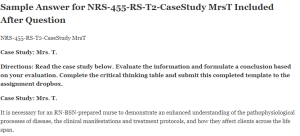Sample Answer for NRS-455-RS-T2-CaseStudy MrsT Included After Question
NRS-455-RS-T2-CaseStudy MrsT
Case Study: Mrs. T.
Directions: Read the case study below. Evaluate the information and formulate a conclusion based on your evaluation. Complete the critical thinking table and submit this completed template to the assignment dropbox.
Case Study: Mrs. T.
It is necessary for an RN-BSN-prepared nurse to demonstrate an enhanced understanding of the pathophysiological processes of disease, the clinical manifestations and treatment protocols, and how they affect clients across the life span.
Evaluate the Health History and Medical Information for Mrs. T., presented below.
Health History and Medical Information
Mrs. T., a 42-year-old female, has been living at home with her two high school age children, husband, and dog. She is a schoolteacher who works full-time teaching at the local grade school. She tries to be active by walking with her husband and dog for 20 minutes on the weekend but is starting to add weight as she gets older. She has no known allergies. She is a pack-a-day smoker and drinks three glasses of wine/per night after work. She tries to eat healthy but likes to eat out at fast food restaurants to avoid having to cook.
Medical history includes atrial fibrillation controlled with beta blocker, hypercholesterolemia, mild anemia related to heavy menses, and migraines. Current medications include:
-

NRS-455-RS-T2-CaseStudy MrsT Metoprolol 50mg daily
- Pravastatin 40 mg at bedtime daily for cholesterol
- Birth control pill Microgestin Fe in the AM
- Amitriptyline 20 mg/daily for migraines
Case Scenario
You are the school nurse where Mrs. T. works. While at recess duty, another teacher runs up to you and reports that Mrs. T. is not acting like herself. When you approach, you see her sitting on a bench mumbling something to the kids gathered around her. She has dropped her cell phone on the ground, and her right arm appears limp. You try asking her questions and you notice the right side of her face is slacken, and she does not seem to be making sense when talking. You call an ambulance, and try to walk her back to your office, but she does not move well. You reassure her and try to determine if anything occurred prior to her loss of speech and movement. The other teachers say it came on suddenly, within the last 5 minutes. Mrs. T. shakes her head no to pain.
Objective Data – Completed by Ambulance Personal:
- Temperature: 36.5 degrees C
- BP 184/92, HR 101, RR 24, Pox 99%
- Blood Glucose = 107
- Positive FAST & VAN score, NIHSS = 12
- Height: 62 inches; Weight 89 kg
Laboratory/Test Results – On Arrival to the Emergency Department (Initial Results)
- WBC: 9.4 (1,000/uL)
- INR – 0.7
- CT Head is normal.
- Negative pregnancy test
- Cholesterol – 247, Triglycerides – 302
Critical Thinking Table
| Clinical Manifestations
Describe the clinical manifestations present in Mrs. T., focusing on what is normal and abnormal and how this relates to her current condition. |
|
| Subjective | |
| Objective | |
| Primary and Secondary Diagnoses
Discuss the primary and secondary medical diagnoses that should be considered for Mrs. T., and why you chose this diagnosis. |
|
| Primary medical diagnosis and why you chose this diagnosis. | |
| Secondary medical diagnosis and why you chose this diagnosis. | |
| Formulate a nursing diagnosis from the medical diagnoses | |
| Pathophysiological Changes
Explain the pathophysiological changes in Mrs. T. |
|
| What pathophysiological changes would you expect to be happening to Mrs. T.? | |
| How will pathophysiological changes transition in the subacute phase after diagnosis and initial treatment? | |
| Health Status Effect
Describe the effects Mrs. T.’s current health status may have on her. |
|
| Describe the physical, psychological, and emotional effects Mrs. T.’s current health status may have on her. | |
| Discuss the impact it can have on her role in the family. | |
| Treatments and Support
Discuss treatments and support that can be completed for Mrs. T. |
|
| Discuss the immediate treatments that can be completed for Mrs. T. | |
| Describe the long-term support she may need to return to baseline activity level. | |
| Explain how the interdisciplinary team is utilized to help her family support and cope with her diagnosis. | |

